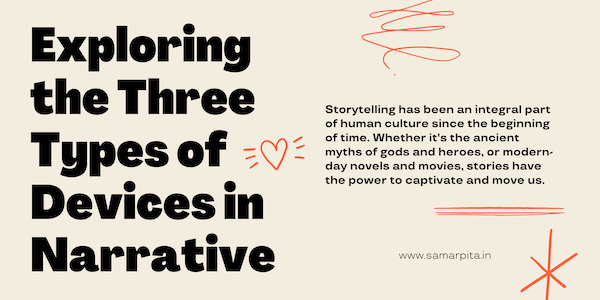Storytelling has been an integral part of human culture since the beginning of time. Whether it’s the ancient myths of gods and heroes, or modern-day novels and movies, stories have the power to captivate and move us. To create a compelling story, writers use a variety of devices to engage the audience and keep them interested. In this blog post, we’ll explore the three types of devices in storytelling, with examples and anecdotes to illustrate their use.
Also Read: 7 Reasons Why Every Book Needs A Good Editor
Plot Devices:
Plot devices are elements of a story that move the narrative forward and create tension and conflict. One of the most common plot devices is foreshadowing, where a hint is given about something that will happen later in the story. For example, in the Harry Potter series, the presence of the lightning-shaped scar on Harry’s forehead foreshadows his connection to the evil wizard, Voldemort.
Another popular plot device is the flashback, where the story goes back in time to reveal important information about a character or event. The classic film Citizen Kane uses flashbacks to explore the life of Charles Foster Kane, a powerful and enigmatic figure whose past is slowly revealed to the audience.
Also Read: Tips To Get Your Children To Read Books
Finally, cliffhangers are a popular plot device used to keep the audience engaged and eager to know what happens next. A cliffhanger occurs when a story ends with a unresolved tension, leaving the audience wondering what will happen next. One example of a famous cliffhanger is the ending of the first season of the TV show Stranger Things, where the character Will Byers disappears and the audience is left wondering if he is alive or dead.
Character Devices:
Character devices are elements of a story that develop the characters and their relationships with each other. One example of a character device is the character arc, where a character undergoes a transformation throughout the course of the story. In the Lord of the Rings trilogy, the character Frodo Baggins undergoes a character arc, where he goes from an innocent hobbit to a heroic figure willing to sacrifice everything to destroy the One Ring.
Also Read: Five Reasons Why Your Business Needs Content Marketing
Internal conflicts are another example of character devices, where a character struggles with their own emotions or desires. In the classic novel Wuthering Heights, the character Heathcliff is torn between his love for Catherine and his desire for revenge against those who have wronged him.
Finally, dialogue is a powerful character device that can reveal a character’s personality, motivations, and relationships. In the film Pulp Fiction, the dialogue between hitmen Jules and Vincent reveals their different attitudes towards their work and their relationship with each other.
Setting Devices:
Setting devices are elements of a story that create the world in which the story takes place. One example of a setting device is the description of the environment, which can create a mood or atmosphere for the story. In the novel Frankenstein, the dark and foreboding setting of the laboratory where the monster is created contributes to the overall horror of the story.
Also Read: 10 Things To Remember When Your Manuscript Is Being Edited
Cultural or historical references are another example of setting devices, which can ground a story in a specific time or place. In the novel To Kill a Mockingbird, the setting of the deep south in the 1930s is used to explore issues of racism and injustice.
Finally, symbolism is a powerful setting device that can add layers of meaning to a story. In the novel The Great Gatsby, the green light at the end of Daisy’s dock symbolizes Gatsby’s hopes and dreams for the future, as well as his inability to attain them.
Also Read: How To Become A Pro At Content Creation Right From The Beginning
In conclusion, the three types of devices in storytelling, plot devices, character devices, and setting devices, are essential tools for writers to create compelling and engaging stories. By using these devices effectively, writers can create stories that captivate audiences and leave a lasting impression.
This post is part of #BlogchatterA2Z challenge
***
If you are looking for an excellent manuscript editor, someone to create content for your business, or an expert to help build your personal or professional brand on social media, then look no further and connect with me at editor@samarpita.in I can be followed on instagram at @samarpita and on twitter at @samarpitadotin.
***********
Read my ebook WRITE. EDIT. PROMOTE. to learn the basics about becoming an author – from writing your own book, to editing your first draft, and to promoting your book yourself! You can also read my ebook How To Write A Story Effectively and learn some valuable lessons about how a story can go from average to extraordinary. This book is part 1 of the series.
In fiction, I have two short stories for children in an ebook called Bedtime Stories.


